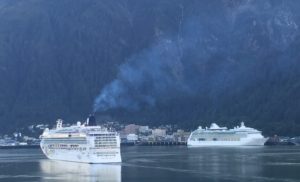
Visitors arrive on early morning cruise Ship – Juneau, AK
As a 36-year resident of Juneau and Ketchikan, I welcome the annual flood of travelers who visit each year. It’s not the economic effect of more than 1 million visitors who will arrive by cruise ship in Juneau (population 32,000) this summer. Nor is it that my son is a helicopter pilot, although I’m happy he lives nearby. My openness to such a crowd is this: I believe that people who see and experience Southeast Alaska’s beauty and culture become owners of our landscape, taking home memories and feelings that support Alaska and Alaskan’s in the long run.
Three… no two… no one (!) day of comparative quiet remains in Juneau. One day until the parade of 1000-foot long cruise ships passes our house, up to six on the average day, each with 2500 passengers and 900 crew members. Float planes will roar off the water and helicopters will land on the glaciers of the Juneau Icefield.
What will they see and feel as they arrive and explore our place in the world? Will they take home a memory that leads them to support protection of our wildlife, wise use of our resources, respect for our culture? What will they learn from the rapidly receding Mendenhall Glacier? Will they see it as a signal of what may disappear from their home landscapes as climate changes?
I’d like them to gain a sense of what is important to Alaskans, to the people of Juneau from all walks of life. Today, the last quiet day in Juneau, I would like to share what counts for me in the everyday love of my place. And, I’ll suggest three of my favorite indoor places to learn about Alaska and Juneau, faithfully hoping that they won’t need help in finding the more obvious outdoor places.
Last Quiet Days in Juneau
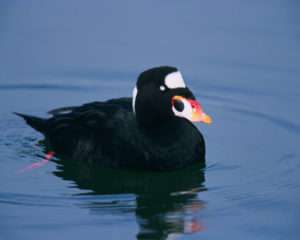
Surf-Scoter
For now, I sit on my deck, listening to hundreds of surf-scoters diving for blue mussels in the shallow water of Gastineau Channel below. I’m 50 feet above them and a full street back, but their gabbling sounds like 400 black chickens excited to discover that they’ve evolved into super-swimmers and diving champions in the dark green saltwater. A barge approaches in the center of the channel, spooking several hundred scoters into whistling wing flight and I miss the chance for a video. Listen to the calls and wing whistles of surf-scoters at Audubon’s website.
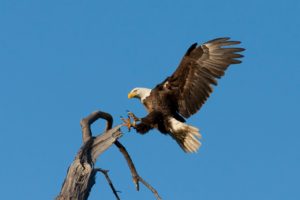
Bald eagle landing on perch tree. Eagles like perch trees that provide a good view of the water as they search for food.
A bald eagle floats in from down channel, looking slow because it’s just gliding, not even a single wing-beat, but actually shooting along at speed. It adjusts its wings at the last moment and sweeps upward to rise the last 15 feet to a perfect standstill at the top of the Sitka Spruce tree behind our house. This is the same eagle that wakes us with its shrill warbling call… no not the scream you hear in the movies, which is dubbed in, usually a red-tailed hawk from somewhere to the south of Alaska while the eagle just lip-syncs. You can compare the calls at the National Audubon Society’s wonderful website. Click the linked names here and scroll down to the Songs and Calls section for each: Listen to the Red-tailed Hawk. Listen to the Bald Eagle.
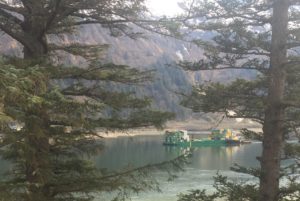
Barge arriving in Juneau. Without an road connection to the outside world, Juneau depends on barges to bring in groceries and everything else found in stores. Barges also carry fish from processing facilities and other products out to markets.
The scoters settle back into their feeding now that the barge is tied up on the far side of the channel. Those startled into flight circle back, their heavy bodies landing in white streaky splashes that from this distance almost look like Dall porpoises surfacing. I was going to say they calm down, but there’s nothing calm about the random chaos of scoters feeding: birds crowded together, swimming in every direction. And yet, the pattern of the flock isn’t random from my eagle’s eye point of view, bunched together in a 40-foot-wide crowd very close to shore where the mussel beds are best. And when not feeding, scoters can be as organized as the most disciplined ant colony, stringing out single file to play follow-the-leader.
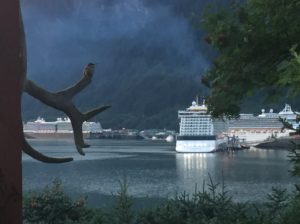
Rufous Hummingbird watches Cruise ships from perch on caribou antler in Juneau Alaska. No caribou remain in Southeast Alaska, although there is evidence that they lived here during the ice age, when oceans were much lower.
Across the water, the docks and anchorages await the cruise passenger pilgrimage to Juneau. The ships will idle past our house early each morning, their bridge just about the height of our picture window, eyeball to eyeball with the captain; then disappear like brightly lit specters in the evening, just after the time the rufous hummingbirds go to their roosts.
Although traveling by cruise ship isn’t for me, I want these visitors to find what I’m always seeking when I travel: a sense of the place and people, what makes us want to live here. I want them to value not just Juneau as a city, but as a city shaped by its history and landscape, by the people who lived here before Europeans and Russians arrived. I want them not just to see, but to feel the power of this Southeast Alaska archipelago of 20,000 islands and rocks scattered across the channels on which the cruise ships float. I want them to love this landscape.
I want them to experience Southeast Alaska in a personal way: to touch the water, to walk a trail, to feel the gravity of rainforests, to see a whale or seal or salmon or eagle, to gaze at the mountains and glaciers and ocean. I want them to seek out some flavor of what I hold dear. At the very least I hope they explore beyond the cruise line-owned jewelry stores and souvenir shops near the docks. And I hope they seek out the shops still owned by local people. I don’t think these are so hard to recognize. I hope they look for local artists and writers and entrepreneurs. Yes, I know– that’s a lot of hoping. But I happily seek the same answers when I travel to far off places.
Special Museums and Cultural Center
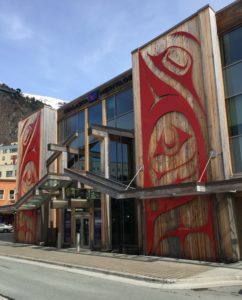
Sealaska Heritage Foundation’s Walter Soboleff Center, Juneau, Alaska. The center features both contemporary and traditional art by Tlingit, Haida, and Tsimshian artists.
Here are three indoor experiences that are within easy walking distance of the cruise ship docks. Downtown Juneau has changed much in recent years, although it has always offered more than jewelry shops. Sealaska Heritage Foundation has created the Walter Soboleff Center, covered with pungent Alaska yellow cedar on the outside, featuring modern and traditional art by Tlingit, Haida, and Tsimshian artists. Inside, there’s a replica clan house, and a small but fascinating collection of traditional clothing and objects with explanations of how these fit into daily life. I remember the dedication ceremony for the Soboleff Center, named for Dr. Walter Soboleff, so long a beacon of hope and love and leadership in our community. I thrilled at the painted canoes that arrived from far points of Southeast Alaska. I watched the Tlingit, Haida, and Tsimshian people in deep red and black blankets and clothing. We all laughed as Raven dancers surprised the crowd into jumping back as they clacked the beaks of their Raven masks.
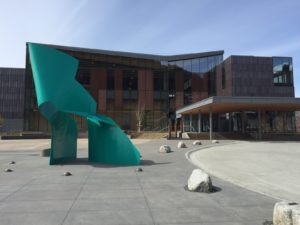
AK State Library-Archives-Museum with Nimbus sculpture opened in 2016.
The new Alaska State Library, Archives, and Museum is also downtown, a world-class building with exceptional exhibits, including special summer exhibits that feature the art collection of the museum, as well as art on loan from 30 artists around the state.
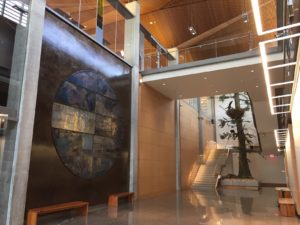
AK State Library-Archives-Museum interior with life size eagle nest tree exhibit
Alaska State Museum exhibits touch on indigenous cultures, Russian Alaska, mining, and the history since Alaska was purchased from Russia 150 years ago in March 1867. The State Archives and Library on the second floor is no less handsome, and worth visiting.
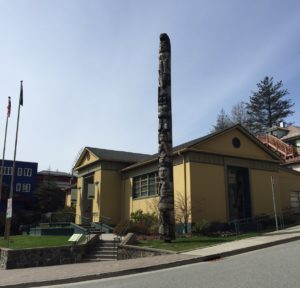
On July 4, 1959, the 49-star U.S. Flag was raised in front of what is now the Juneau Douglas City Museum to celebrate Alaska statehood. Across from State Capitol building
The Juneau Douglas City Museum is Juneau’s own display of history in a town (the highly competitive towns of Juneau and Douglas became one in 1970) that grew up around three of the largest gold mines in the world from the early 1900’s to 1940. It’s a museum easy to miss, but is only three short blocks from downtown, across the street from the State Capitol Building and on the way to the Governor’s Mansion.
On the 4th of July, 1959, Alaska celebrated statehood in front of what is now the Juneau Douglas City Museum. The flag with 49 stars was raised, and a bell was rung 49 times. Fast forward to July 4th, 2009, when all but one of the living Alaska State Governors gathered again to celebrate Alaska’s 50th anniversary of statehood. For me, this ceremony was very special. The place, the museum, and the moment brought home much of what I feel about Alaska as a state. I joined the throng and celebrated with my heart in my throat, so grateful to make my life here.
Visitors will find many other exhibits, museums, trails, recreational opportunities, and tours worth experiencing, both downtown and farther afield. Zooming out, Juneau rests within the landscape and region of Southeast Alaska, just one of 32 communities, each with its own story, some with origins in Tlingit, Haida, or Tsimshian communities reaching back in to the past, others like Juneau more recent upstarts. Their stories are there to explore.
Alaskans have strong traditions of sharing gifts of the land, hospitality of our homes, and the landscape that we live in. I ask only that our visitors treat the land and people with respect. I hope they will seek new experiences, whether in rain or sunshine. I hope they will take away a vision and love for the place that I love.
After Note: Please Express Your Support
This blog post was prompted when the City of Juneau announced that it was considering closure of the Juneau Douglas City Museum, a great loss in my opinion. Since then, the Borough Assembly has removed the museum from the 2017 budget cut list in response to strong support from Juneau residents. The cultural centers and museums in Juneau and other Southeast Alaska communities need your support. As you visit their websites and when you visit them in person, please express your support to their staff, on their websites, and through donations.